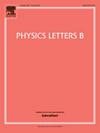Explaining the γγ + X excesses at ≈151.5 GeV via the Drell-Yan production of a Higgs triplet
IF 4.3
2区 物理与天体物理
Q1 ASTRONOMY & ASTROPHYSICS
引用次数: 0
Abstract
The multi-lepton anomalies suggest the existence of a new scalar with a mass between 145 GeV and 155 GeV, which is compatible with indications of the associated production of a narrow resonance with a mass of ≈151 GeV. These anomalies require a sizable branching fraction of the new scalar to WW. However, because no ZZ signal at this mass has been observed, this implies that the new boson could be the neutral component of an triplet with zero hypercharge. This field leads to a positive definite shift in the W mass and is produced via the Drell-Yan process . We use the side-bands of the ATLAS analysis [1] of the associated production of the Standard Model Higgs in the di-photon channel to search for this production mode of the triplet. Since the dominant decays of depend only on its mass, the effect in the 22 signal categories considered by ATLAS is completely correlated. Combining all channels in a likelihood ratio test, we find that a non-zero Br, with a best-fit value of 0.66%, is preferred by ≈3σ for a mass of ≈151.5 GeV. While this mass is consistent with the multi-lepton anomalies, there is also an excess at ≈127 GeV with a significance of 3.6σ. However, the latter is inconsistent with the mass predicted by the multi-lepton anomalies and is in close proximity to the SM Higgs mass, suggesting the possibility of enhanced associated production of the SM Higgs.
求助全文
约1分钟内获得全文
求助全文
来源期刊

Physics Letters B
物理-物理:综合
CiteScore
9.10
自引率
6.80%
发文量
647
审稿时长
3 months
期刊介绍:
Physics Letters B ensures the rapid publication of important new results in particle physics, nuclear physics and cosmology. Specialized editors are responsible for contributions in experimental nuclear physics, theoretical nuclear physics, experimental high-energy physics, theoretical high-energy physics, and astrophysics.
 求助内容:
求助内容: 应助结果提醒方式:
应助结果提醒方式:


